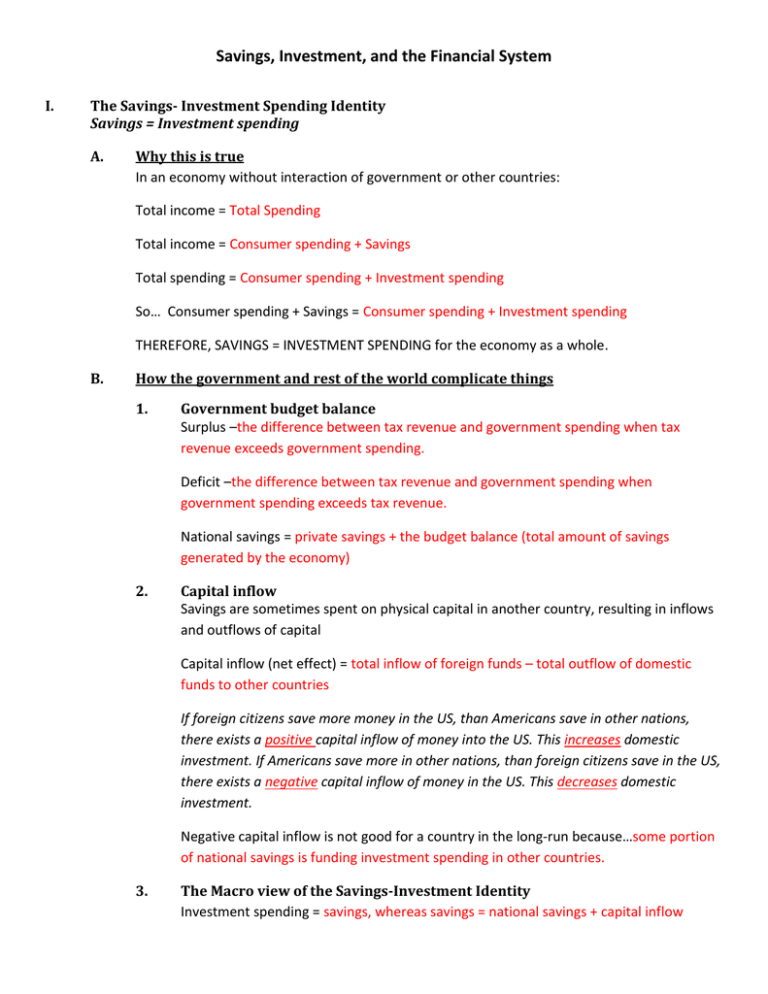THEREFORE, SAVINGS = INVESTMENT SPENDING for the
advertisement

Savings, Investment, and the Financial System I. The Savings- Investment Spending Identity Savings = Investment spending A. Why this is true In an economy without interaction of government or other countries: Total income = Total Spending Total income = Consumer spending + Savings Total spending = Consumer spending + Investment spending So… Consumer spending + Savings = Consumer spending + Investment spending THEREFORE, SAVINGS = INVESTMENT SPENDING for the economy as a whole. B. How the government and rest of the world complicate things 1. Government budget balance Surplus –the difference between tax revenue and government spending when tax revenue exceeds government spending. Deficit –the difference between tax revenue and government spending when government spending exceeds tax revenue. National savings = private savings + the budget balance (total amount of savings generated by the economy) 2. Capital inflow Savings are sometimes spent on physical capital in another country, resulting in inflows and outflows of capital Capital inflow (net effect) = total inflow of foreign funds – total outflow of domestic funds to other countries If foreign citizens save more money in the US, than Americans save in other nations, there exists a positive capital inflow of money into the US. This increases domestic investment. If Americans save more in other nations, than foreign citizens save in the US, there exists a negative capital inflow of money in the US. This decreases domestic investment. Negative capital inflow is not good for a country in the long-run because…some portion of national savings is funding investment spending in other countries. 3. The Macro view of the Savings-Investment Identity Investment spending = savings, whereas savings = national savings + capital inflow II. The Financial System Where households invest current savings and wealth by purchasing financial assets A. Financial assets versus physical assets Financial asset –a paper claim that entitles the buyer to future income from the sellers Physical asset –a claim on a tangible object that gives the owner the right to dispose of the object as he or she wishes B. Three Tasks of the Financial System 1. Reducing transaction costs Transaction costs –expenses of negotiating and executing a deal How the financial market reduces these: Instead of dealing with the high costs of negotiating individual loans from thousands of different people, a business or household can avoid large transaction costs by involving only a single borrower and a single lender. (Ex. Getting a loan or selling bonds or stock) 2. Reducing risk Risk –uncertainty about future outcomes that involve financial losses and gains How the financial market reduces this: A well-functioning financial system helps people reduce their exposure to risk by allowing others to share the risk of investment, even if that requires sharing some of the profit. The goal in combating risk is achieving diversification. Diversification – investing in several assets with unrelated, or independent, risks 3. Providing liquidity Liquidity – the ability for an asset to quickly be converted into cash without much loss of capital How the financial market provides this: There is always a danger of needing to get money back before the term of a loan is up. Investing in stocks and bonds are a partial answer to the problem of liquidity. III. Types of Financial Assets Asset (define) Purpose Loans – a lending agreement between an individual lender and an individual borrower Loan-backed securities – assets created by pooling individual loans and selling shares in that pool (a process called securitization) Can help finance a car/house or purchase of physical capital *Extremely popular recently* Provides avenue for a guaranteed return on investment and opportunity for banks to give out more loans How these function Advantages/ Disadvantages A borrower wants to make an Loans are tailored to the needs of the investment; a lender wants to borrower. make a profit by charging interest Loans typically involve high on the principal provided up front. transaction costs. A bank pools similar loans Provide more diversification and together and sells the package to liquidity than individual loans. investors. Now the investors will Difficulty in assessing true quality of receive the monthly payments of asset. interest rate and principal. The bank can now continue to lend out more money and change loan origination fees. Seller of bond promises to pay a Avoids costly transaction fees and fixed some of interest each year easy to resell. and repay the principal to owner Risk of bond defaulting: the bond by designated date. issuer might fail to make payments as specified by the bond contract. Bonds – an IOU issued by the borrower (firm) Creates a more streamlined approach for major corporations and governments to receive initial sums of money to invest without costly negotiations involved with loans. Stocks – a share in the ownership of a company Few individuals are risk-tolerant enough to face the risk involved in being the sole owner of a large company. By purchasing stock, you can receive a high rate of return over time. If you purchase a share (stock) of a company, you are entitled to that given amount of that company’s profit, as well as that given amount of votes on company decisions. Bank deposits – a claim on a bank that obliges the bank to give the depositor his or her cash when demanded Holding assets in a bank account is secure and the quickest way to access cash. For many small/moderate size companies, the cost of issuing bonds and stocks is too large, given the modest amount of money needed. A bank works by first accepting funds from depositors; when you put your money in a bank, you are essentially becoming a lender by lending the bank your money. The bank then keeps a fraction of ready cash and loans the rest. Business owners can share the risk of investment and improves welfare of investors who buy stock. If a company goes under, shareholders typically receive nothing. (Bond is a promise, Stock is a hope.) The bank operates on the assumption that only a small fraction of its depositors will want their cash at the same time. A “run on the bank” may enfold if too many depositors want their money back at once. IV. Financial Intermediaries Institutions that transform funds into financial assets ( About ¾ of financial assets Americans own are through intermediaries) Intermediary (define) Mutual funds – a financial intermediary that creates a stock portfolio and then resells shares of this portfolio to individual investors Pension Funds – nonprofit institutions that collect the savings of their members in order to provide retirement income to its members. Life Insurance Companies — sell policies that guarantee a payment to a policyholder’s beneficiaries when the policyholder dies. Banks – financial intermediary that provides liquid assets in the form of bank deposits to lenders and uses those funds to finance the illiquid investment spending needed of borrowers. Purpose How these function Advantages/ Disadvantages By owning a diversified portfolio of If you don’t have a large amount of Investors with less money can hold stocks—a group of stocks in which money to invest, building a a diversified portfolio, and achieve risks are unrelated to, or offset, diversified stock portfolio can incur a better return for any given level one another—rather than high transaction costs. Mutual of risk. concentrating investment in the funds solve this problem without Mutual funds charge fees for their shares of a single company or a high cost. services, especially if mutual funds group of related companies, claim to have special expertise in investors can reduce their risk. This investing money, your fees can be applies to diversifying your entire quite high. wealth by holding other assets. “Savings today, rewards tomorrow.” Provides retirees income based off of the amount previously saved by the retirees. By enabling policy holders to cushion their beneficiaries from financial hardship arising from their death, life insurance companies also improve welfare by reducing risk. (same as bank deposits) Pension funds function much like “Must save for a rainy day.” mutual funds. They invest in a To have money in the future, you diverse array of financial assets, must forgo spending it now. allowing their members to achieve more cost-efficient diversification and conduct more market research than they would be able to individually. (same as bank deposits) (same as bank deposits)







